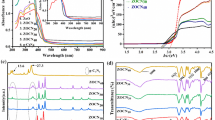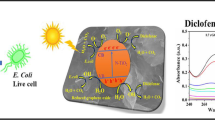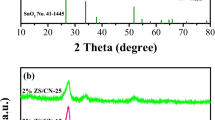Abstract
In this work, a comparative study of three frequently employed modification techniques to g-C3N4 (CN) nanosheets for the photocatalytic degradation of metribuzin (MET) under visible-light irradiation has been carried out in detail. The modification methods were coupling TiO2 nanoparticles (TO) as electron acceptors, nano-sized Fe2O3 (FO) to construct a Z-scheme nanocomposite, and phosphate (HP) modification to promote O2 adsorption. The steady-state and transient-state surface photovoltage spectra and transient photoluminescence (PL) spectra confirmed that all the three modification techniques enhanced the charge separation with prolonged lifetimes and presented degradation activities in the order of TO/CN > FO/CN > HP/CN. The TO/CN nanocomposite showed the highest photocatalytic activity for MET degradation, with a sixfold higher rate than bulk CN. Liquid chromatography–tandem mass spectrometry and radical trapping experiments indicated that the increased activity was related to the synergetic effect of two radicals (·O2− and ·OH) involved in the photocatalytic degradation pathway, which was different from the ·OH radical-dominated pathway of bulk CN. This work reveals the importance of charge separation and the influence of the radical pathway and provides guidance for the design of high-efficiency photocatalysts.
Graphical abstract

摘要
本文以可见光催化降解嗪草酮 (MET)为应用, 通过对比研究复合宽带隙TiO2纳米颗粒(TO) 作为电子接收平台、复合纳米Fe2O3 (FO)构建Z型异质结复合体和修饰磷酸(HP)促进O2吸附的三种常用的促进g-C3N4 (CN)光生电荷分离的修饰方法, 研究提高CN基光催化性能的可行策略。通过稳态、瞬态表面光电压谱和瞬态光致发光(PL)谱等分析表明, 三种修饰策略均能促进CN的光生电荷分离, 延长光电子使用寿命。可见光催化降解MET实验表明, 降解活性依次为TO/CN > FO/CN > HP/CN。TO/CN纳米复合材料对MET的光催化降解活性最高, 是普通CN的6倍。通过液相色谱-串联质谱和自由基捕获等实验表明, TO/CN活性的提高是因为•O2−和•OH两个自由基协同参与光催化降解路径的新机制, 而普通的CN样品则表现为单一的•OH自由基主导路径。结合光物理分析, 这种新机制可能是由于TO作为高水平能级电子能量平台, 促进了电荷分离且维持了CN光生电子的热力学能力, 提高了光生电子的还原能力, 从而产生•O2−和•OH自由基。这项工作揭示了电荷分离和自由基路径影响的重要性, 并为高效光催化剂的设计提供了指导。






Similar content being viewed by others
References
Sanford M, Washuck N, Carr K, Prosser RS. Pulsed exposure of the macrophyte lemna minor to herbicides and the mayfly neocloeon triangulifer to diamide insecticides. Chemosphere. 2021;273:128582.
Abdul QW, Samina A, Jochen AM, Muhammad A, Samina I. Immobilization of metribuzin degrading bacterial consortium MB3R on biochar enhances bioremediation of potato vegetated soil and restores bacterial community structure. J Hazard Mater. 2020;390:121493.
André LCB, Daniel ASR, Camila CRFC, Igor ASC, Daiana RES, Silvana QS, Robson JCFA. Aqueous chlorination of herbicide metribuzin: identification and elucidation of “new” disinfection by-products, degradation pathway and toxicity evaluation. Water Res. 2021;189(1):116545.
Aziz HY, Soheila AK, Solmaz F, Afsar R. Review on heterogeneous photocatalytic disinfection of waterborne, airborne, and foodborne viruses: can we win against pathogenic viruses. J Colloid Interface Sci. 2020;580(15):503.
Sun J, Zhang M, Wang ZF, Chen HY, Chen Y, Naoya M, Teruhisa O. Synthesis of anatase TiO2 with exposed 001 and 101 facets and photocatalytic activity. Rare Met. 2019;38(4):287.
Li LJ, Hu ZF, Jimmy C, Yu OD. Synthesis of H2O2 by water oxidation for sustainable resource production and organic pollutant degradation. Angew Chem Int Ed. 2020;59(46):20538.
Chen F, Ma TY, Zhang TR, Zhang YH, Huang HW. Atomic-level charge separation strategies in semiconductor-based photocatalysts. Adv Mater. 2021;33(10):2005256.
Sun ZX, Wang HQ, Wu ZB, Wang LZ. g-C3N4 based composite photocatalysts for photocatalytic CO2 reduction. Catal Today. 2018;300(1):160.
Soheila AK, Aziz HY. g-C3N4/carbon dot-based nanocomposites serve as efficacious photocatalysts for environmental purification and energy generation: a review. J Clean Prod. 2020;276(10):124319.
Cao SW, Li H, Tong T, Chen HC, Yu AC, Yu JG, Chen HM. Single-atom engineering of directional charge transfer channels and active sites for photocatalytic hydrogen evolution. Adv Funct Mater. 2018;28(32):1802169.
Wang XC, Maeda K, Arne T, Takanabe K, Xin G, Carlsson JM, Domen K, Antonietti M. A metal-free polymeric photocatalyst for hydrogen production from water under visible light. Nat Mater. 2009;8(1):76.
Wang XS, Zhou C, Shi R, Liu QQ, Waterhouse GIN, Wu LZ, Tung CH, Zhang TR. Supramolecular precursor strategy for the synthesis of holey graphitic carbon nitride nanotubes with enhanced photocatalytic hydrogen evolution performance. Nano Res. 2019;12(9):2385.
Li J, Wu DD, Iocozzia J, Du HW, Liu XQ, Yuan YP, Zhou W, Li Z, Xue ZM, Lin ZQ. Achieving efficient incorporation of π-electrons into graphitic carbon nitride for markedly improved hydrogen generation. Angew Chem Int Ed. 2019;58(7):1985.
Wang YX, He FT, Chen L, Shang J, Wang JJ, Wang SJ, Song HM, Zhang JQ, Zhao CC, Wang SB, Sun HQ. Acidification and bubble template derived porous g-C3N4 for efficient photodegradation and hydrogen evolution. Chin Chem Lett. 2020;31(10):2668.
Li XW, Wang B, Yin WX, Di J, Xia JX, Zhu WS, Li HM. Cu2+ modified g-C3N4 photocatalysts for visible light photocatalytic properties. Acta Phys Chim Sin. 2020;36(3):1902001.
Yu HJ, Shi R, Zhao YX, Bian T, Zhao YF, Zhou C, Waterhouse GIN, Wu LZ, Tung CH, Zhang TR. Alkali-assisted synthesis of nitrogen deficient graphitic carbon nitride with tunable band structures for efficient visible-light-driven hydrogen evolution. Adv Mater. 2017;29(16):1605148.
Zhu BC, Cheng B, Zhang LY, Yu JG. Review on DFT calculation of s-triazine-based carbon nitride. Carbon Energy. 2019;1(1):32.
Wang HL, Zhang LS, Chen ZG, Hu JQ, Li SJ, Wang ZH, Liu JS, Wang XC. Semiconductor heterojunction photocatalysts: design, construction, and photocatalytic performances. Chem Soc Rev. 2014;43(15):5234.
Zhang WD, Dong XA, Liang Y, Liu R, Sun YJ, Dong F. Synergetic effect of BiOCl/Bi12O17Cl2 and MoS2: in situ DRIFTS investigation on photocatalytic NO oxidation pathway. Rare Met. 2019;38(5):437.
Zhang Y, Zhao SM, Su QW, Xu JL. Visible light response ZnO-C3N4 thin film photocatalyst. Rare Met. 2021;40(1):96.
Low JX, Jiang CJ, Cheng B, Wageh S, Al-Ghamdi AA, Yu JG. A review of direct z-scheme photocatalysts. Small Methods. 2017;1(5):1700080.
Raziq F, Sun LQ, Wang YY, Zhang XL, Humayun M, Ali S, Bai LL, Qu Y, Yu HT, Jing LQ. Synthesis of large surface-area g-C3N4 comodified with MnOx and Au-TiO2 as efficient visible-light photocatalysts for fuel production. Adv Energy Mater. 2018;8(3):1701580.
Qi Y, Zhao Y, Gao YY, Li D, Li Z, Zhang FX, Li C. Redox-based visible-light-driven Z-scheme overall water splitting with apparent quantum efficiency exceeding 10%. Joule. 2018;2(11):2393.
Kumar A, Raizada P, Singh P, Saini RV, Saini AK, Hosseini-Bandegharaeie A. Perspective and status of polymeric graphitic carbon nitride based Z-scheme photocatalytic systems for sustainable photocatalytic water purification. Chem Eng J. 2020;391(1):123496.
Yang F, Chu XY, Sun JH, Zhang YH, Li ZJ, Liu HY, Bai LL, Qu Y, Jing LQ. Efficient singlet oxygen generation by excitonic energy transfer on ultrathin g-C3N4 for selective photocatalytic oxidation of methyl-phenyl-sulfide with O2. Chin Chem Lett. 2020;31(10):2784.
Xing YP, Wang XK, Hao SH, Zhang XL, Wang X, Ma WX, Zhao G, Xu XJ. Recent advances in the improvement of g-C3N4 based photocatalytic materials. Chin Chem Lett. 2021;32(1):13.
Zheng Y, Chen YL, Gao BF, Lin BZ, Wang XC. Black phosphorus and carbon nitride hybrid photocatalysts for photoredox reactions. Adv Funct Mater. 2020;30(30):2002021.
Jing LQ, Wang DD, He MQ, Xu YG, Xie M, Song YH, Xu H, Li HM. An efficient broad spectrum-driven carbon and oxygen co-doped g-C3N4 for the photodegradation of endocrine disrupting: mechanism, degradation pathway, DFT calculation and toluene selective oxidation. J Hazard Mater. 2021;401(5):123309.
Liu C, Jing LQ, He LM, Luan YB, Li CM. Phosphate-modified graphitic C3N4 as efficient photocatalyst for degrading colorless pollutants by promoting O2 adsorption. Chem Commun. 2014;50(16):1999.
Zhang XL, Zhang XX, Li JD, Sun JH, Bian J, Wang JS, Qu Y, Yan R, Qin CL, Jing LQ. Exceptional visible-light activities of g-C3N4 nanosheets dependent on the unexpected synergistic effects of prolonging charge lifetime and catalyzing H2 evolution with H2O. Appl Catal B Environ. 2018;237:50.
Luan P, Xie MZ, Fu XD, Qu Y, Sun XJ, Jing LQ. Improved photoactivities of TiO2/Fe2O3 nanocomposites for visible-light water splitting after phosphate bridging and mechanism. Phys Chem Chem Phys. 2015;17(7):5043.
Liu C, Jing LQ, He LM, Luan YB, Li CM. Phosphate-modified graphitic C3N4 as efficient photocatalyst for degrading colorless pollutants by promoting O2 adsorption. Chem Commun. 2014;50(16):1999.
Luan YB, Jing LQ, Xie Y, Sun XJ, Feng YJ, Fu HG. Exceptional photocatalytic activity of 001-facet-exposed TiO2 mainly depending on enhanced adsorbed oxygen by residual hydrogen fluoride. ACS Catal. 2013;3(6):1378.
Wu YQ, Gao F, Wang HM, Kovarik L, Sudduth B, Wang Y. Probing acid–base properties of anatase TiO2 nanoparticles with dominant 001 and 101 facets using methanol chemisorption and surface reactions. J Phys Chem C. 2021;125(7):3988.
Zhang P, Wang T, Chang XX, Gong JL. Effective charge carrier utilization in photocatalytic conversions. ACC Chem Res. 2016;49(5):911.
Chen RT, Fan FT, Dittrich T, Li C. Imaging photogenerated charge carriers on surfaces and interfaces of photocatalysts with surface photovoltage microscopy. Chem Soc Rev. 2018;47(22):8238.
Humayun M, Qu Y, Raziq F, Yan R, Li ZJ, Zhang XL, Jing LQ. Exceptional visible-light activities of TiO2-coupled N-doped porous perovskite LaFeO3 for 2,4-dichlorophenol decomposition and CO2 conversion. Environ Sci Technol. 2016;50(24):13600.
Wu H, Kong XY, Wen XM, Chai SP, Lovell EC, Tang JW, Ng YH. Metal-organic framework decorated cuprous oxide nanowires for long-lived charges applied in selective photocatalytic CO2 reduction to CH4. Angew Chem Int Ed. 2021;60(15):8455.
Sun N, Qu Y, Yang CH, Yang ZD, Yan R, Wenyu E, Zhang ZQ, Li ZJ, Li HN, Khan I, Sun R, Jing LQ, Fu HG. Efficiently photocatalytic degradation of monochlorophenol on in-situ fabricated BiPO4/β-Bi2O3 heterojunction microspheres and O2-free hole-induced selective dechloridation conversion with H2 evolution. Appl Catal B Environ. 2020;263:118313.
Liu W, Zhang W, Liu MS, Du PH, Dang CY, Liang JL, Li YY. Fabrication of niobium doped titanate nanoflakes with enhanced visible-light-driven photocatalytic activity for efficient ibuprofen degradation. Chin Chem Lett. 2019;30(12):2177.
Lei XM, You MH, Pan F, Liu M, Yang P, Xia DS, Li Q, Wang YT, Fu J. CuFe2O4@GO nanocomposite as an effective and recoverable catalyst of peroxymonosulfate activation for degradation of aqueous dye pollutants. Chin Chem Lett. 2019;30(12):2216.
Li ZJ, Luan YB, Qu Y, Jing LQ. Modification strategies with inorganic acids for efficient photocatalysts by promoting the adsorption of O2. ACS Appl Mater Interfaces. 2015;7(41):22727.
Jiang ZF, Wan WM, Li HM, Yuan SQ, Zhao HJ, Wong PK. A hierarchical Z-scheme α-Fe2O3/g-C3N4 hybrid for enhanced photocatalytic CO2 reduction. Adv Mater. 2018;30(10):1706108.
Acknowledgements
This work was financially supported by the National Natural Science Foundation of China (Nos. 21971057 and U1805255), the Natural Science Foundation of Heilongjiang Province (Nos. YQ2019B006 and LH2020B012) and the Postdoctoral Research Foundation of Heilongjiang Province (No. LBH-Q19052), the Outstanding Youth Fund of Heilongjiang University (No. JCL201901), and the Basic Scientific Research Expenses of Colleges and Universities in Heilongjiang Province (No. 2020-KYYWF-1008).
Author information
Authors and Affiliations
Corresponding authors
Ethics declarations
Conflict of interests
The authors declare that they have no conflict of interest.
Supplementary Information
Below is the link to the electronic supplementary material.
Rights and permissions
About this article
Cite this article
Yan, R., Zada, A., Sun, L. et al. Comparative study of metal oxides and phosphate modification with different mechanisms over g-C3N4 for visible-light photocatalytic degradation of metribuzin. Rare Met. 41, 155–165 (2022). https://doi.org/10.1007/s12598-021-01857-3
Received:
Revised:
Accepted:
Published:
Issue Date:
DOI: https://doi.org/10.1007/s12598-021-01857-3




